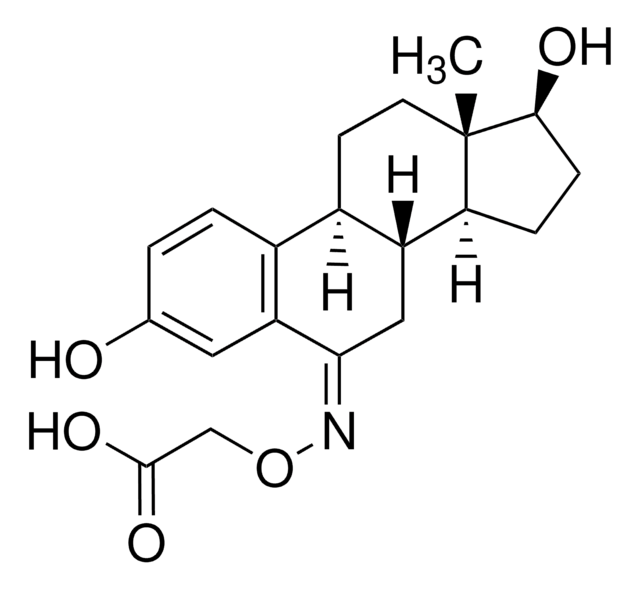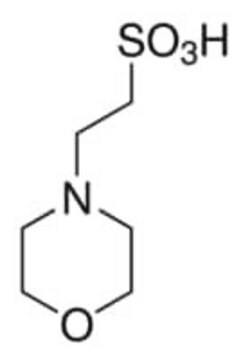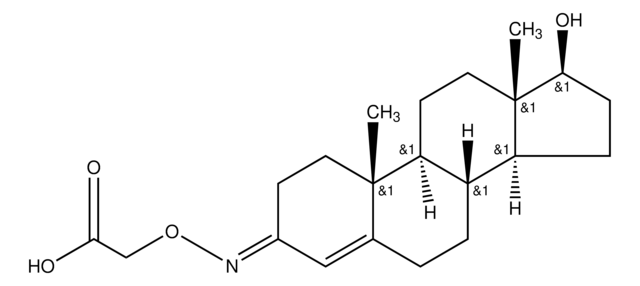Kluczowe dokumenty
M2933
MES hydrate
BioPerformance Certified, suitable for cell culture, ≥99.5%
Synonim(y):
2-Morpholineethanesulfonic acid hydrate, 2-(N-Morpholino)ethanesulfonic acid hydrate, 4-Morpholineethanesulfonic acid
About This Item
Polecane produkty
Poziom jakości
klasa czystości
BioPerformance Certified
for molecular biology
Próba
≥99.5%
Formularz
crystalline powder
warunki przechowywania
dry at room temperature
metody
cell culture | mammalian: suitable
immunofluorescence: suitable
nucleic acid detection: suitable
zanieczyszczenia
endotoxin and Total Aerobic Microbial Count, tested
kolor
white
przydatny zakres pH
5.5-6.7
pKa
6.1
rozpuszczalność
water: 335.3 g/L at 20 °C
przydatność
suitable for component for culture media
suitable for molecular biology
Zastosowanie
agriculture
diagnostic assay manufacturing
life science and biopharma
sample preparation
obecność zanieczyszczeń
DNase, RNase, protease, none detected
ciąg SMILES
O.OS(=O)(=O)CCN1CCOCC1
InChI
1S/C6H13NO4S.H2O/c8-12(9,10)6-3-7-1-4-11-5-2-7;/h1-6H2,(H,8,9,10);1H2
Klucz InChI
MIIIXQJBDGSIKL-UHFFFAOYSA-N
Szukasz podobnych produktów? Odwiedź Przewodnik dotyczący porównywania produktów
Opis ogólny
Beyond these applications, MES hydrate buffer is widely used in regulating pH in plant culture media, reagent solutions, and physiological experiments. It′s the preferred choice for studying the effects of pH on enzymatic reactions and investigating the interactions of proteins and other biomolecules with metal ions. As a Good′s buffer, MES hydrate meets stringent criteria of having a midrange pKa, maximum water solubility, minimal solubility in other solvents, minimal salt effects, stability across different temperatures, chemical and enzymatic stability, minimal absorption in the visible and UV spectral range, and ease of synthesis. Furthermore, it does not form complexes with most metal ions, ensuring reliable outcomes in applications involving metal ions.
Zastosowanie
- To suspend cells before autophagic induction studies
- In the preparation of Murashige and Skoog growth medium for the growth of Arabidopsis thaliana seedlings
- In the conjugation of hybridization probes to beads before PCR amplification
- To treat fibroblast-derived matrix before conjugation with heparin for use as a vascular endothelial growth factor delivery platform
- as a wash buffer in a study about molecular biology
- as a component of culture media
Cechy i korzyści
- Suitable for Molecular Biology and Cell Culture
- Can be used as a Buffer component, for Electrophoresis and Protein separation
- Tested for Endotoxins and Total Aerobic Microbial Count
- Free from DNase, NICKase, RNase, and Protease
- Tested to confirm low levels of heavy metal contamination, ensuring suitability for various applications
- Effective Buffering from pH 5.5-6.7 (25 °C) with a pKa of 6.1 (25 °C)
- Highly soluble in water
- Minimal metal ion binding
- Less toxic to cells than other buffers such as Tris and phosphate
- Stable in a wide pH range
- Low UV absorptivity
- Minimal reactivity
Uwaga dotycząca przygotowania
Przechowywanie i stabilność
Inne uwagi
Kod klasy składowania
11 - Combustible Solids
Klasa zagrożenia wodnego (WGK)
WGK 1
Temperatura zapłonu (°F)
Not applicable
Temperatura zapłonu (°C)
Not applicable
Środki ochrony indywidualnej
Eyeshields, Gloves
Wybierz jedną z najnowszych wersji:
Masz już ten produkt?
Dokumenty związane z niedawno zakupionymi produktami zostały zamieszczone w Bibliotece dokumentów.
Klienci oglądali również te produkty
Nasz zespół naukowców ma doświadczenie we wszystkich obszarach badań, w tym w naukach przyrodniczych, materiałoznawstwie, syntezie chemicznej, chromatografii, analityce i wielu innych dziedzinach.
Skontaktuj się z zespołem ds. pomocy technicznej









